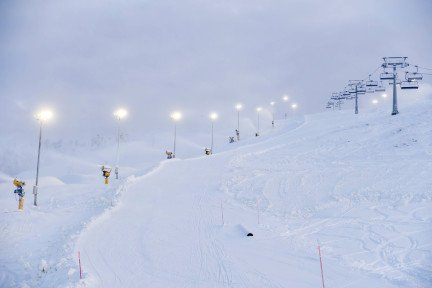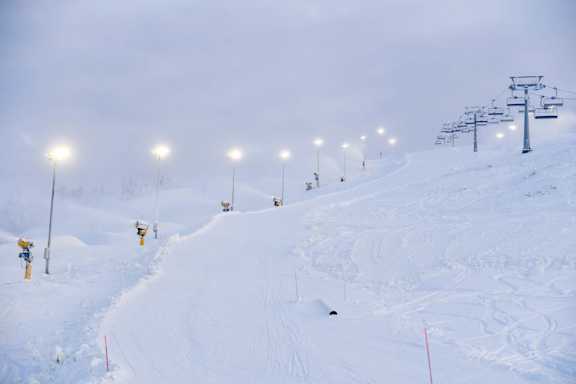
How automated snowmaking helps improve our energy efficiency
Levi’s location in Lapland is excellent in terms of guaranteed snow. Still we need to also resort to making snow. And that is why the resource and energy efficiency of snowmaking is important for the environmental efforts at Levi Ski Resort.
Automated snowmaking conserves energy and optimises water consumption. We have made continuous investments into automating our significant fleet of snow guns since 2005. We already have 307 automated snow guns.
We asked Hannu Levinheimo, who has had a long career in snowmaking at Levi Ski Resort, about the development of snowmaking over the years
– I started with snowmaking at Levi in 1985 when we got the first pipeline into the slope. We had four snow blowers at the time, all of which were operated manually. Today, the majority of the snow guns are automatic and can be controlled remotely over a data network. Automation does not eliminate footwork on the field, but in terms of energy and water savings it has brought a great change. Thanks to advanced weather automation and remote control, the same amount of water and energy produces significantly more snow today than it did five years ago, Hannu says.
– The basic principle of snowmaking has not really changed over time. Snow is produced by spraying pressurized water into the air through a fan or a long, compressed air whistle, whereby it crystallizes into snow in sub-zero temperatures.
– The key difference today is that we are able to react immediately and accurately to the ever-changing weather conditions, such as in wind direction. Our automated snow guns are only operational when the conditions for snow production are good in that specific part of the slope.

HIGHER QUALITY SNOW BASED ON DATA
We set limit values for the automated snow guns to determine the temperatures in which the guns are allowed to operate and when they need to switch off. They are equipped with weather sensors collecting observation data that helps optimize e.g. water pressure and the amount of water. This improves the quality of the snow while conserving water.
– Manual snow guns require more time to prep, start and stop and operating them is much more laborious. If there is a large number of manual guns in use, responding to changed weather conditions will inevitably be slower, because adjustments must be made on site, Hannu continues.
– Experience also impacts efficiency. We have a set team of experts reserved for snowmaking, who strive to get the job done with as little snow as possible. We are relatively accurate in estimating how much snow is needed, and we constantly monitor snow-gun specific comparative data on water consumption from previous years. We attempt to make as little snow as needed. This saves energy and water as well as minimizes the amount of meltwater in the spring, which causes erosion.
RAPIDLY CHANGING WEATHER CONDITIONS PACE THE WORK
The conditions of the fell largely determine where snow can be made. For anyone who is unfamiliar with the process, it may seem strange that snow guns are operating in different areas, and not evenly throughout the slope. The main reason for this is usually the wind direction.
– Beyond frost, wind is the most decisive factor in snowmaking. Snow can only be made into tailwind, and not headwind. If wind conditions are unfavorable, guns are not used. For this reason, most of the guns are placed on the south and west sides of the slope, as west and south winds are most prevalent in the fells, Hannu explains.
– Wind also spins in the fell, which makes conditions quite capricious. Snow gun manufacturers are trying to make guns that take wind direction into account, but this is not yet a reliable feature. We constantly monitor the direction of the wind at different parts of the fell and remotely switch guns on and off according to the weather data.
COOPERATION IS IMPORTANT
Slope Manager Teemu Hämäläinen and the trail and snowmaking supervisor Jouko Majava work together in snow construction and snowmaking. Jouko's responsibilities include organizing the snowmaking season as well as maintaining cross-country ski and snowmobile trails. You can read more about slope and trail machines here.
- I have been involved in snowmaking and snow construction since 2007. We add to the snowmaking system on the fell almost every year, making the system very familiar to us. We continuously develop the system by adding new guns and by constructing and maintaining the groundwork, ensuring that maintenance is minimized during snowmaking operations, says Jouko.
A comprehensive automated system requires solid expertise from the snowmaking team. We train our staff annually to ensure the snowmaking process runs as smoothly as possible. Snowmaking accounts for approximately one-third of the ski resort's electricity consumption, which is why it is important to focus on energy efficiency.
- With automation, the snowmaking team has become smaller, but on the other hand, the skill requirement has increased. Besides mastering the basic operation of the equipment and safe movement in the fell, one must also manage the system's IT aspect, Jouko explains.
The overall management of slope work is overseen by the Slope Manager. For the smoothness and efficiency of the work, it is important for different functions to collaborate seamlessly.
- The workflow is such that once snowmaking begins, the slope machinery side spreads the snow onto the slope, ensuring the adequacy of the snow amount. The goal is to always produce the right amount of snow in the right place, making the successful collaboration between machine operators and snowmaking crucial. The slope is then finalized by the ski lift maintenance, ensuring marking and protection, after which the slope is safe to open to customers, comments Teemu.
Learn about the different dimensions of sustainability at Levi Ski Resort here. Be sure to also share your own environmental deeds with us under the #sustainablelevi tag in social media!


